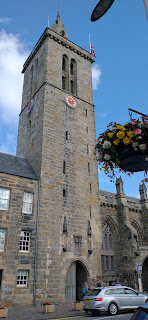This July I'm considering the different ways we can research for our fiction. I know I've done this before and I know I will do this again. It's not my fiction-writing side that pushes me to find more explanations and better explanations. It's my academic side. I’ve been examining how Germans view their Jewish past pre-1700, and comparing that with the fiction we read and wondering how we can beat our own biases. I explored one approach in person, imagining a town as a museum and discovering the stories it told and what the stories missed.
The town is called Eden, and I’m writing from an apartment near Aslings Beach. Eden was named after the first Earl of Auckland and. It has a twofold bay, where the waves argue with each other. One set of waves dominates and roars, the other growls. If you listen closely, the soundscape is as complex as the history the people remember and much simpler than Eden’s real history.
Eden almost became the capital of Australia. Before the Europeans arrived, it was the land of the Yuin people, who are still here. How do I know they are still here? A family of them caught the bus with me the day before yesterday. A young family, with possibly the cutest child in existence. I was going to the Killer Whale Museum. That bus trip and that museum reminded me that towns can be a lot more complicated and interesting than the books written about them. Whether this is a story of the family I saw on the bus, Old Tom, a killer whale who bossed a whaling fleet, a Jewish whaler, or the white Christian men the town celebrates (the Imlays, Mr Boyd, Mr Logan, the Davidsons) depends on how you walk down the street, how you interpret the museum, and whether our own biases can be used to redress those in the sources we use for our research.
The Yuin were in what is now Eden long before Cicero wrote about the Antipodes in the Somnium Scipionis. They’ve never left. The Yuin people have an excellent council, and I need to look at what that Council does and maybe ask some questions to delve further into their history before I can understand who they are and what they have done since the first arrival of Europeans here in the 19th century. Why do I say carefully "I need to delve"? Yuin folks are depicted in the Killer Whale Museum and in the street heritage notices as a secondary part of the town’s history. This is a shabby description of ancient history. If you walk the heritage trails, there is better treatment. It’s like Twofold Bay – stand in one place and you will hear something quite different to standing just a kilometre away.
This stranded history where the strands don’t always touch, it hides stuff. Only one man died from whaling in all the decades Eden was a whaling centre. The low death rate looks as if it may well be due to locals sharing their expertise with Imlays and the Davidsons. But was the expertise shared as between equals, or even willingly? This knowledge can’t be gleaned from looking at how history is presented publicly.
Except…
when it is. The Yuin are in the museum in photographs of boats in
Twofold Bay, but school history, food history, council affairs
(except the specific council for Indigenous locals), the management
of the town and the life of locals is depicted as white. Even the
Jewish residents (not quite white, in Australian tradition) shadow
white male history, which is curious, because there are Jewish graves
in the local cemetery, an important early shop was set up by someone
Jewish, and Solomon Solomons, of a particularly important regional
family, was a Jewish whaler.
Now
I wonder how many Jewish whalers there are, and whether it's simply
that no-one talks about them. There were Jewish pirates and Jewish
politicians – why should there be no Jewish whalers? And why do so
many fiction writers assume we are all involved in matters financial?
Mr Solomons was a vast local importance and his family was of
regional importance, so his absence from the Killer Whale Museum is
curious. More curious, however, is the absence of most Yuin people in
the main history of the region. They have history, and it’s shown,
but separately, as if the European-origin culture cannot talk to the
Indigenous. The depiction of women in the museum too, makes them
secondary to the Really Important People. This is modern Australia in
miniature. We set up the history we want to live with and create a
past that echoes ourselves. When historical fiction writers use this
as a base for writing, the circle is complete.
How
to move out of this closed circle? One of the bus drivers of Eden
solved this as he explained what happened to the Greenseas Tuna
Factory. “You need to ask the right people the right questions,”
he said. Why is this not so easy in Eden? The current population
of Eden is mostly older people who migrated from elsewhere. They
wanted to retire to a lovely town on the coast and they have no
knowledge of what came before. The desk person at the Killer Whale
Museum demonstrated beautifully how new knowledge is acquired in the
region: she is passionate about the Mr Logan who built Edrom Lodge.
She is determined to make him visible, because she sees him as
unseen. My clever bus driver and the schoolteacher on a stall at the
community market both knew her and her passion. It’s a small town:
everyone knows those with passion. And so the fascination with one
person is reinforced and the wider story of the townsfolk says
different things depending on where the story is focused. I have a
list of names of people who will know more: I will return sometime
and ask them my questions. Time and work break down that circle, and
the clever asking of questions.
We
seek stories of people like us, for the most part. When I asked about
the local inhabitants and their work with killer whales, no-one I
spoke to could answer my questions beyond the answers the museum
gave. Each of them was focused on what they knew, and on people they
thought were like themselves. Sometimes, however, the answers are in
sight. I will need to speak to the local Land Council, for example,
and the Jewish Historical Society.
I
can (and did) also ask different questions. I can look for people who
are not quite like others.
In
the case of Eden, the most obvious person is Old Tom, a killer whale
of great significance. The Killer Whale Museum chronicles his life
and his personality and why he was named. His stories show that the
real cultural force in the whole whaling industry was not those who
sold whale products and made much money: it was the Indigenous
whalers who worked alongside the Killer Whales. We know how Old Tom
handled his team of orcas to bring whales in for the kill. We know
how he let the whalers know they needed to get in their boats and do
their bit. We know how he mocked whalers who would not do their share
of the work or did not leave Tom and his folks their part of the
kill. We even know how he was patted. We also know, mainly from the
pictures at the museum, that it was not the white Australians who
worked with Old Tom. They were exceptionally skilled people. There
was a great deal that was different in Eden to whaling elsewhere,
from the number of whales killed (maintaining a population) to the
collaboration between human and killer whales and the number of
people who died whaling. One. Just one human death. Over decades.
Look at an exhibition from a different point of entry and it is as if
the whole past shifts and changes and suddenly makes sense.
Whether
a writer chooses one strand or two, whether they only see the
official history and follow the path of the Imlay brothers down the
main street (the Princes Highway, the #1 road in Australia, which
becomes Imlay Street as it passes through Eden) or whether the writer
challenges standard history and starts to think of the locals who
never left ... this rests on the type of story the novelist wants to
tell. Most will tell stories that link to known heroes and
established figures and will echo the sound of the larger bay. Their
research will echo the interests of the new locals, who retired to
Eden and don't know its deep history. Their story will reinforce the
standard one and will resound and be seen and valued because it
echoes what we already know. Other writers will echo the smaller bay
and query Old Tom. Rare writers will look at history from somewhere
else entirely and will bring us something very special indeed.














.webp)






_2.webp)











